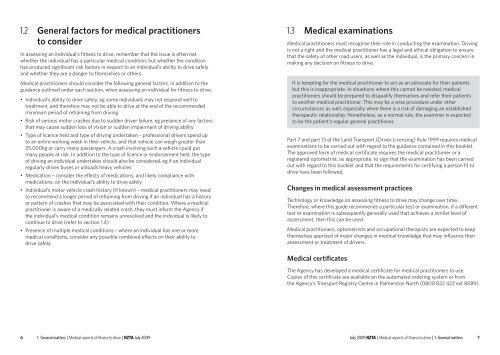Medical aspects of fitness to drive a guide for medical practitioners
Medical aspects of fitness to drive a guide for medical practitioners
Medical aspects of fitness to drive a guide for medical practitioners
Create successful ePaper yourself
Turn your PDF publications into a flip-book with our unique Google optimized e-Paper software.
1.2<br />
General fac<strong>to</strong>rs <strong>for</strong> <strong>medical</strong> <strong>practitioners</strong><br />
<strong>to</strong> consider<br />
In assessing an individual’s <strong>fitness</strong> <strong>to</strong> <strong>drive</strong>, remember that the issue is <strong>of</strong>ten not<br />
whether the individual has a particular <strong>medical</strong> condition, but whether the condition<br />
has produced significant risk fac<strong>to</strong>rs in respect <strong>to</strong> an individual’s ability <strong>to</strong> <strong>drive</strong> safely<br />
and whether they are a danger <strong>to</strong> themselves or others.<br />
<strong>Medical</strong> <strong>practitioners</strong> should consider the following general fac<strong>to</strong>rs, in addition <strong>to</strong> the<br />
guidance outlined under each section, when assessing an individual <strong>for</strong> <strong>fitness</strong> <strong>to</strong> <strong>drive</strong>:<br />
• Individual’s ability <strong>to</strong> <strong>drive</strong> safely, eg some individuals may not respond well <strong>to</strong><br />
treatment, and there<strong>for</strong>e may not be able <strong>to</strong> <strong>drive</strong> at the end <strong>of</strong> the recommended<br />
minimum period <strong>of</strong> refraining from driving<br />
• Risk <strong>of</strong> serious mo<strong>to</strong>r crashes due <strong>to</strong> sudden <strong>drive</strong>r failure, eg presence <strong>of</strong> any fac<strong>to</strong>rs<br />
that may cause sudden loss <strong>of</strong> vision or sudden impairment <strong>of</strong> driving ability<br />
• Type <strong>of</strong> licence held and type <strong>of</strong> driving undertaken – pr<strong>of</strong>essional <strong>drive</strong>rs spend up<br />
<strong>to</strong> an entire working week in their vehicle, and that vehicle can weigh greater than<br />
25,000kg or carry many passengers. A crash involving such a vehicle could put<br />
many people at risk. In addition <strong>to</strong> the type <strong>of</strong> licence or endorsement held, the type<br />
<strong>of</strong> driving an individual undertakes should also be considered, eg if an individual<br />
regularly <strong>drive</strong>s buses or unloads heavy vehicles<br />
• Medication – consider the effects <strong>of</strong> medications, and likely compliance with<br />
medications, on the individual’s ability <strong>to</strong> <strong>drive</strong> safely<br />
• Individual’s mo<strong>to</strong>r vehicle crash his<strong>to</strong>ry (if known) – <strong>medical</strong> <strong>practitioners</strong> may need<br />
<strong>to</strong> recommend a longer period <strong>of</strong> refraining from driving if an individual has a his<strong>to</strong>ry<br />
or pattern <strong>of</strong> crashes that may be associated with their condition. Where a <strong>medical</strong><br />
practitioner is aware <strong>of</strong> a <strong>medical</strong>ly related crash, they must in<strong>for</strong>m the Agency if<br />
the individual’s <strong>medical</strong> condition remains unresolved and the individual is likely <strong>to</strong><br />
continue <strong>to</strong> <strong>drive</strong> (refer <strong>to</strong> section 1.4)<br />
• Presence <strong>of</strong> multiple <strong>medical</strong> conditions – where an individual has one or more<br />
<strong>medical</strong> conditions, consider any possible combined effects on their ability <strong>to</strong><br />
<strong>drive</strong> safely.<br />
1.3<br />
<strong>Medical</strong> examinations<br />
<strong>Medical</strong> <strong>practitioners</strong> must recognise their role in conducting the examination. Driving<br />
is not a right and the <strong>medical</strong> practitioner has a legal and ethical obligation <strong>to</strong> ensure<br />
that the safety <strong>of</strong> other road users, as well as the individual, is the primary concern in<br />
making any decision on <strong>fitness</strong> <strong>to</strong> <strong>drive</strong>.<br />
It is tempting <strong>for</strong> the <strong>medical</strong> practitioner <strong>to</strong> act as an advocate <strong>for</strong> their patients<br />
but this is inappropriate. In situations where this cannot be resisted, <strong>medical</strong><br />
<strong>practitioners</strong> should be prepared <strong>to</strong> disqualify themselves and refer their patients<br />
<strong>to</strong> another <strong>medical</strong> practitioner. This may be a wise procedure under other<br />
circumstances as well, especially when there is a risk <strong>of</strong> damaging an established<br />
therapeutic relationship. Nonetheless, as a normal rule, the examiner is expected<br />
<strong>to</strong> be the patient’s regular general practitioner.<br />
Part 7 and part 13 <strong>of</strong> the Land Transport (Driver Licensing) Rule 1999 requires <strong>medical</strong><br />
examinations <strong>to</strong> be carried out with regard <strong>to</strong> the guidance contained in this booklet.<br />
The approved <strong>for</strong>m <strong>of</strong> <strong>medical</strong> certificate requires the <strong>medical</strong> practitioner or a<br />
registered op<strong>to</strong>metrist, as appropriate, <strong>to</strong> sign that the examination has been carried<br />
out with regard <strong>to</strong> this booklet and that the requirements <strong>for</strong> certifying a person fit <strong>to</strong><br />
<strong>drive</strong> have been followed.<br />
Changes in <strong>medical</strong> assessment practices<br />
Technology or knowledge on assessing <strong>fitness</strong> <strong>to</strong> <strong>drive</strong> may change over time.<br />
There<strong>for</strong>e, where this <strong>guide</strong> recommends a particular test or examination, if a different<br />
test or examination is subsequently generally used that achieves a similar level <strong>of</strong><br />
assessment, then this can be used.<br />
<strong>Medical</strong> <strong>practitioners</strong>, op<strong>to</strong>metrists and occupational therapists are expected <strong>to</strong> keep<br />
themselves apprised <strong>of</strong> major changes in <strong>medical</strong> knowledge that may influence their<br />
assessment or treatment <strong>of</strong> <strong>drive</strong>rs.<br />
<strong>Medical</strong> certificates<br />
The Agency has developed a <strong>medical</strong> certificate <strong>for</strong> <strong>medical</strong> <strong>practitioners</strong> <strong>to</strong> use.<br />
Copies <strong>of</strong> this certificate are available on the au<strong>to</strong>mated ordering system or from<br />
the Agency’s Transport Registry Centre in Palmers<strong>to</strong>n North (0800 822 422 ext 8089).<br />
6 1. General matters | <strong>Medical</strong> <strong>aspects</strong> <strong>of</strong> <strong>fitness</strong> <strong>to</strong> <strong>drive</strong> | NZTA July 2009<br />
July 2009 NZTA | <strong>Medical</strong> <strong>aspects</strong> <strong>of</strong> <strong>fitness</strong> <strong>to</strong> <strong>drive</strong> | 1. General matters 7
















